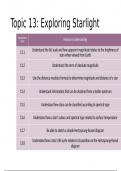Presentation
Telescopic Astronomy, Exploring Starlight
- Course
- Institution
Summary and review notes of Edexcel GCSE Astronomy Paper 2, Topic 13- Exploring Starlight. Here, there are comprehensive notes per specification point, topic-by-topic questions, and exam-style questions specifically related to the Topic. The "Exploring Starlight" topic builds student's understandin...
[Show more]



